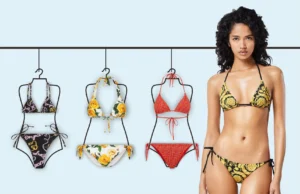Swimsuits are known for their dynamic intersection of style, versatility, and functionality. When it comes to choosing the best swimsuit fabric, we seek materials that define contemporary trends. From the sun-drenched shores to the social media feeds, the spotlight is firmly fixed on innovative fabrics. This makes us wonder about what the best swimsuit fabrics are.
The best swimsuit fabric includes nylon, polyester, microfiber fabrics, neoprene, Lycra, etc. For a contemporary take and style, fabrics like mesh, modal, and jersey knit are also very trendy. Ultimately, choosing the best fabric depends on industry standards and sustainability practices.
For fashion brands and resellers, selecting the best fabric for their swimwear depends on many factors. It includes elements like customer demands, seasonal trends, environmental factors, etc. So, there is much to uncover before you can decide on what is the best swimsuit fabric for you. In this article, we will go through the best swimsuit fabrics to help you decide.
10 Best Swimsuit Fabrics For You To Choose
Choosing the best swimsuit fabric requires us to navigate various elements like style, comfort, fashion, and functionality. Each fabric has something unique to offer to make the swimsuit more attractive. While there are numerous fabrics present in the market, here are the 10 best swimsuit fabrics for you to delve deeper into.
Nylon: The Timeless Performer
Nylon is celebrated for its robustness, making it a durable choice for swimsuit fabric. Its ability to withstand the rigors of regular use, exposure to the sun, and contact with various elements makes it a timeless performer. Additionally, nylon is quick-drying, ensuring that you stay comfortable both in and out of the water.

One of the standout features of nylon is its exceptional stretch. This property allows for a snug and form-fitting swimsuit that complements various body shapes. Furthermore, nylon maintains its shape well over time, ensuring that your swimsuit retains its original silhouette even after multiple wears and washes.
Spandex: Embracing Elasticity
Spandex, also known as Lycra or elastane, is renowned for its remarkable stretch and flexibility. This fabric’s ability to stretch up to several times its original length provides unparalleled freedom of movement.

This makes it an ideal choice for active beachgoers and individuals engaging in water sports. Whether you’re swimming, surfing, or playing beach volleyball, a spandex-infused swimsuit ensures comfort and ease of motion.
The inherent elasticity of spandex makes it particularly suitable for those with an active lifestyle. Swimsuits containing spandex are designed to move with your body, providing a secure fit without compromising on comfort. Whether you’re diving into the waves or lounging on the beach, a spandex-enhanced swimsuit offers the perfect blend of style and functionality.
Polyester: Durable and Resilient

Polyester’s durability extends to its ability to maintain shape over the long term. Whether you’re a casual swimmer or a regular lap swimmer, a polyester swimsuit remains resilient, avoiding sagging or deformation. This quality makes polyester a reliable option for those seeking a durable and low-maintenance swimsuit.
Microfiber: The Soft Touch
Microfiber is a synthetic material known for its lightweight nature and exceptionally soft feel against the skin. This makes microfiber swimsuits comfortable to wear for extended periods, providing a luxurious touch that enhances the overall swimwear experience.

Microfiber is a versatile fabric that accommodates vibrant prints and patterns well. This allows for a wide range of stylish designs, making microfiber swimsuits not only comfortable but also fashionable. Whether you prefer solid colors or eye-catching prints, microfiber offers both style and functionality.
Additionally, microfiber’s quick-drying properties make it an excellent choice for individuals who want to seamlessly transition from water activities to other leisure or social activities. Its moisture-wicking ability ensures that excess water is efficiently drawn away from the body, keeping you dry and comfortable even after leaving the water.
Neoprene: Dive into Performance
Neoprene, commonly associated with wetsuits, has made its mark in the world of swimsuits due to its insulation properties. This makes neoprene swimsuits a popular choice for those engaging in cold-water activities. The material retains body heat, providing a layer of warmth that can enhance comfort in cooler aquatic environments.

Beyond its functional aspects, neoprene’s unique texture and appearance contribute to the creation of trendy and stylish swimsuit designs. Neoprene swimsuits often feature bold and contemporary looks, making them stand out in terms of both performance and fashion.
Neoprene’s buoyant nature is an added benefit for swimmers. It provides a degree of floatation, making it easier to stay afloat and potentially improving swimming performance. This buoyancy factor can be particularly advantageous for individuals participating in water-based fitness activities.
Lycra: Enhancing Stretch
Lycra, also known as spandex or elastane, is a synthetic fabric celebrated for its impressive stretch properties. When blended with other materials, Lycra enhances the overall stretchiness of the swimsuit, providing a snug and comfortable fit that moves with the body.

Swimsuits containing Lycra offer a snug fit that adapts to your body shape, ensuring freedom of movement without sacrificing comfort. This fabric is commonly used in athletic swimwear, where flexibility and support are paramount.
Lycra is resistant to fading, ensuring that your swimsuit maintains its vibrant colors even after exposure to sun, saltwater, or chlorine. This resistance to color degradation contributes to the longevity and aesthetic appeal of Lycra-enhanced swimsuits.
Mesh: Breathable and Stylish
Mesh fabric is characterized by its open and breathable structure, allowing air to circulate freely. When incorporated into swimsuits, mesh provides ventilation, preventing excess heat and moisture buildup. This breathability is particularly beneficial in warm weather or during active water sports.

Mesh is often used as an accent or overlay on other swimsuit materials, adding a touch of style and sophistication. Mesh panels can be strategically placed to create visual interest, enhance the overall design, and provide a fashionable edge to the swimsuit.
Thanks to its open weave, mesh facilitates the quick evaporation of water, contributing to a faster drying process. This feature is advantageous for individuals who want to minimize the time spent in a wet swimsuit, ensuring comfort and convenience.
Tactel: Soft and Lightweight
Tactel is a type of microfiber known for its exceptional softness. When used in swimsuit fabric, Tactel provides a silky and smooth feel against the skin, enhancing overall comfort. Swimsuits made with Tactel are gentle and luxurious, making them a popular choice for those who prioritize a soft touch.

Tactel’s lightweight nature adds to the comfort factor, allowing for a barely-there feel when worn. This makes Tactel swimsuits comfortable for extended periods, whether you’re lounging by the pool or engaging in water activities.
Jersey Knit: Comfortable All-Rounder
Jersey knit is a comfortable and versatile fabric commonly used in swimwear. Its soft and stretchy nature ensures a comfortable fit, accommodating various body shapes. Jersey knit swimsuits provide a relaxed and casual feel, making them suitable for both active and leisurely pursuits.

The breathable quality of jersey knit contributes to overall comfort by allowing air to circulate, preventing overheating. This makes it a suitable option for warm-weather destinations or activities where comfort is paramount.
Modal: Silky Smoothness
Modal is a type of rayon known for its silky smooth texture. When used in swimsuit fabric, Modal provides a luxurious feel against the skin, creating a comfortable and indulgent wearing experience.

Modal is derived from natural fibers, often sourced from beech trees. This makes it an eco-friendly option for those who prioritize sustainability in their clothing choices. Additionally, Modal is highly breathable, allowing air to flow freely through the fabric.
So, the breathability contributes to a cool and comfortable sensation. This feature makes Modal swimsuits a suitable choice for various water-related activities.
Swimsuit Fabric Trends: What Retailers Need to Know
As retailers navigate the ever-evolving landscape of swimwear fashion, staying aware of the latest swimsuit fabric trends is essential. Today’s consumers not only seek stylish designs but also prioritize comfort, functionality, and sustainability. Here are some key trends in swimsuit fabrics that retailers should be aware of.
Sustainability is Stylish
In response to growing environmental awareness, consumers are increasingly drawn to swimsuits made from eco-friendly materials. Fabrics like recycled nylon, organic cotton, and regenerated polyester are gaining popularity. These materials not only appeal to environmentally conscious consumers but also contribute to a positive brand image.
That is why, retailers should consider incorporating sustainable swimsuit options into their inventory. This will help them to meet the rising demand for eco-conscious fashion. Sustainability and ethical sourcing practices will also help them to have transparency with the customers. So, they will stay ahead in the market.
Functionality Meets Fashion
The intersection of fashion and functionality is evident in the rise of innovative performance fabrics. Fabrics with moisture-wicking properties, enhanced breathability, and quick-drying capabilities are becoming staples in swimwear. Consumers are seeking swimsuits that effortlessly transition from water activities to lounging.
In response to this rising demand, retailers can cater to the customers by offering swimsuits crafted from advanced materials. This may include options like high-tech microfibers, neoprene blends, and mesh overlays. Thus, the swimsuits will attain both style and functionality.
Textured and Embellished Fabrics
Swimsuits are not just about comfort and functionality. Aesthetics plays a significant role when it comes to swimsuit fashion and fabrics. Textured and embellished fabrics are gaining traction in swimwear fashion. Fabrics with ribbing, jersey knit, lace overlays, and intricate patterns add a tactile and visually appealing dimension to swimsuits.
Retailers should consider diversifying their inventory by incorporating swimsuit features. Adding the textured and embellished fabrics will cater to the consumers who prioritize both style and substance.
Versatile and Adaptive Fabrics
Consumers are increasingly looking for swimsuits that serve multiple purposes. Versatile and adaptive fabrics that can seamlessly transition from beachwear to casual wear are gaining popularity. Swimsuits with fabrics like jersey knit, Tactel, and soft modal provide comfort and style beyond the shoreline.
That is why, retailers can capitalize on this trend by curating collections that offer swimwear suitable for both water activities and casual outings. This will provide the customers with more value and versatility.
Trendy Materials For The Best Swimsuit Designs
In the ever-evolving world of swimwear fashion, the pursuit of the best swimsuit designs is intimately linked to the materials that are currently setting trends. Sustainability takes center stage with recycled nylon, an eco-conscious choice that aligns with contemporary values.
Renowned celebrities and influencers are increasingly seen donning swimwear crafted from innovative materials. This makes a bold statement about the fusion of style and environmental responsibility. Neoprene blends, once reserved for high-performance wetsuits, have now infiltrated the swimwear scene, showcasing a fusion of innovation and chic design.

Celebrities and influencers flaunt neoprene-infused swimsuits, proving that fashion-forward choices need not compromise functionality. Organic cotton, with its ethical allure, has become a staple in swimwear collections, epitomizing a commitment to both comfort and sustainable practices.
Mesh, once relegated to functional roles, is now a fan favorite. Mesh fabric swimsuits adorned with panels and overlays offer both breathability and visual sophistication. Modal, celebrated for its luxurious feel, is experiencing a resurgence in swimwear, favored by influencers who seek opulence in every detail.
Fashion lovers are embracing ribbed swimsuits for their unique surface appeal, proving that tactile experiences are as important as visual aesthetics. Ultimately, these innovative fabrics and styles are making a wave in terms of swimsuit fabrics and fashion. Thus, both retailers and customers can benefit majorly from knowing more about the trendy materials for swimsuit designs.
Conclusion
The best swimsuit fabric depends on various elements like style, comfort, breathability, and functionality. Selecting the best swimsuit fabric will allow retailers to make versatile and stylish clothing for fashion-forward customers. At the same time, customers can make the best choices for buying their favorite swimsuits when they know about the best fabrics.
So, turn your swimsuit visions into reality by working with the best manufacturers. In this way, you can let your unique style reflect through your beachwear. At MGOO Beachwear, we are helping clothing brands turn their vision into the best quality swimwear. If you have any queries about clothing manufacturing, contact us.












